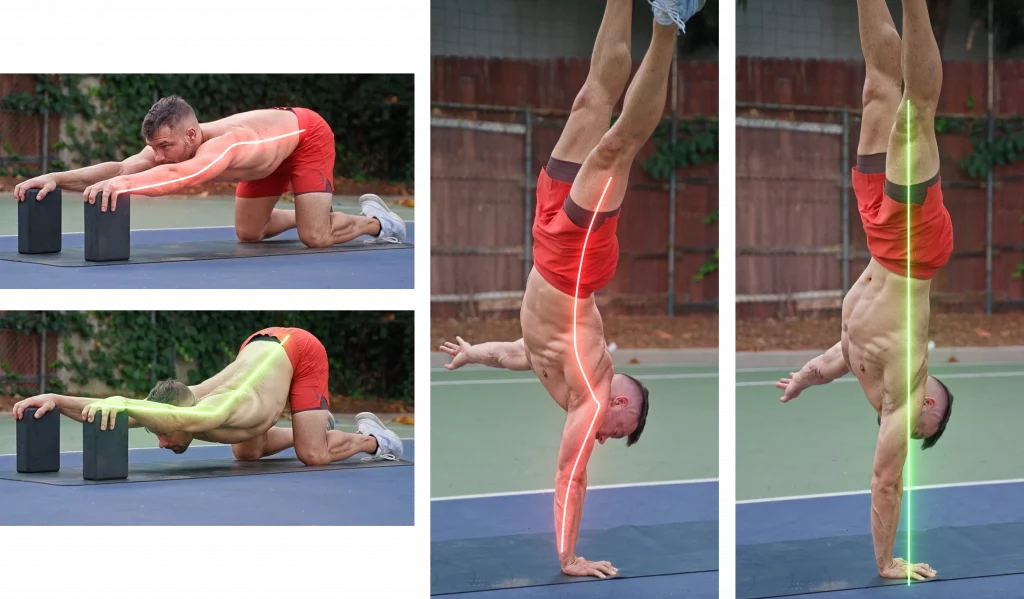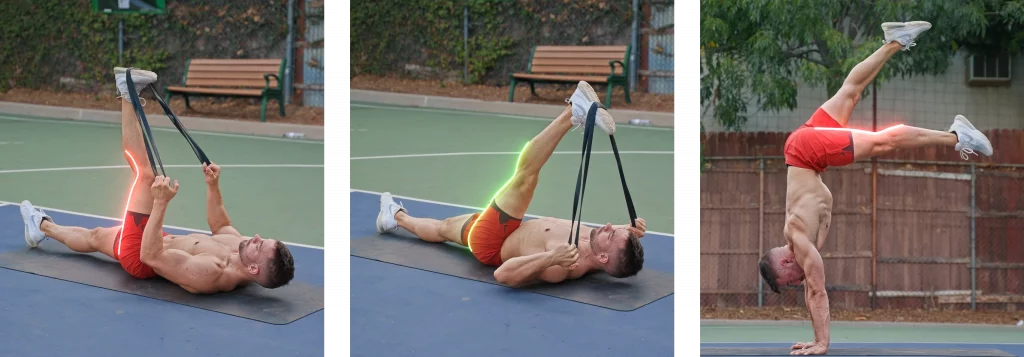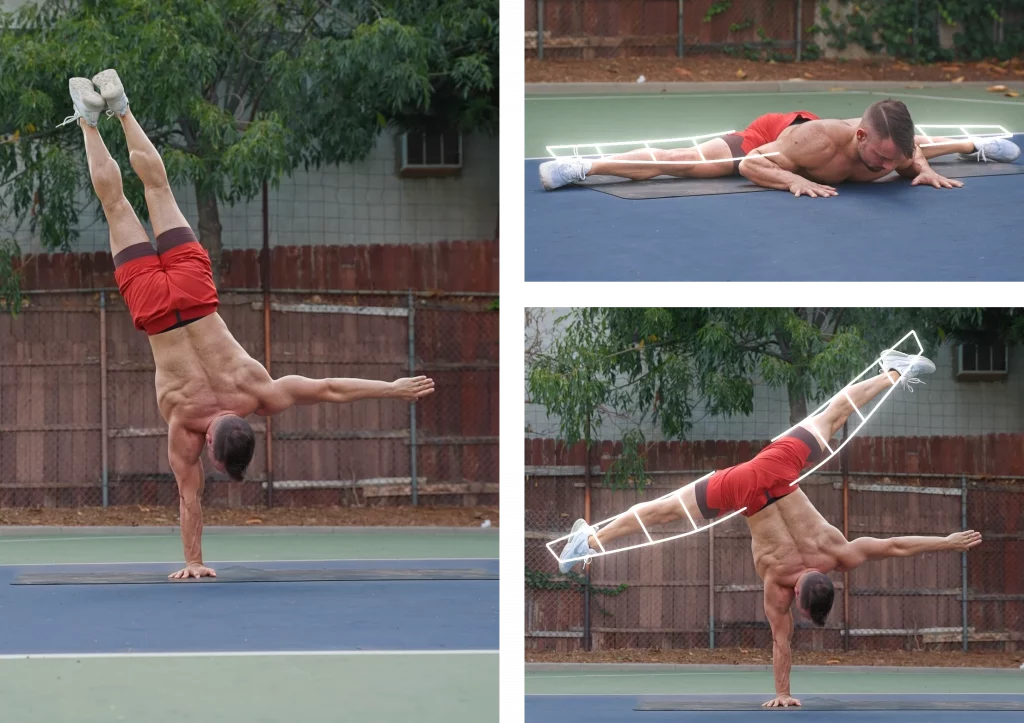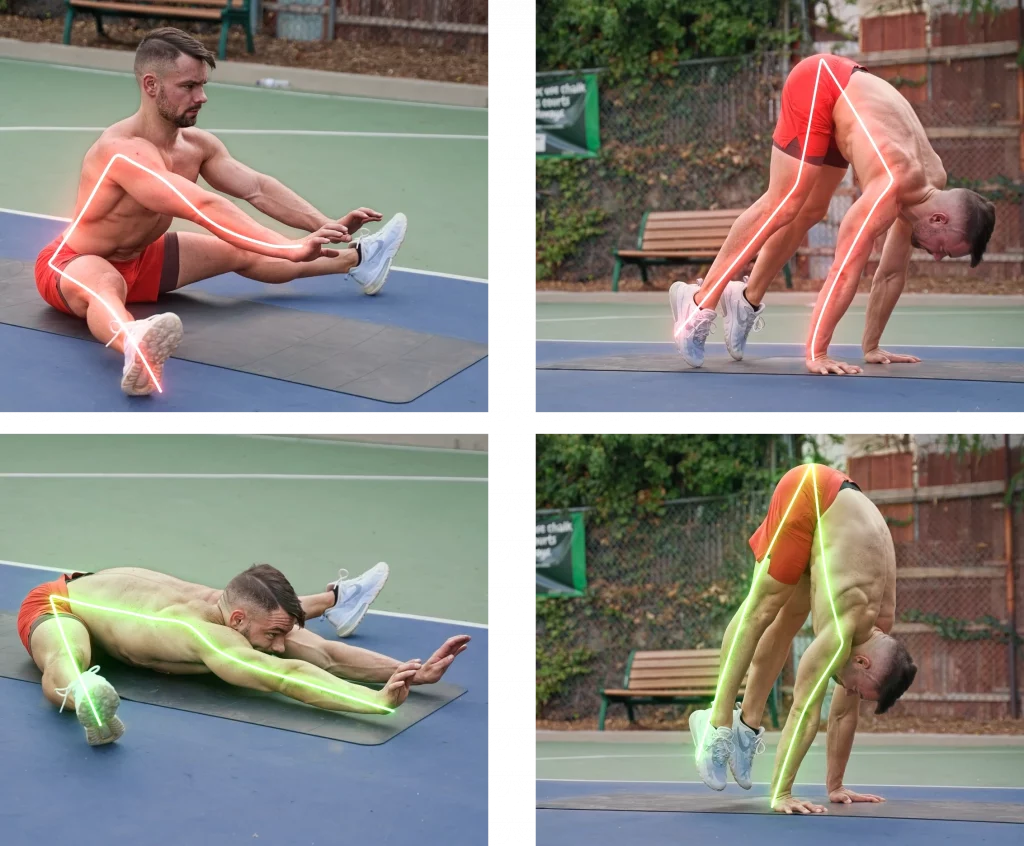Why does flexibility matter?
Flexibility is not necessary to succeed with handstands but it makes things significantly easier. Higher levels of mobility will make your handstands efficient and with that healthy and sustainable.
Your line
If you are not mobile enough to elevate your scapula your shoulders are doomed to be slightly closed. You will create an angle and your back will have to arch to make up for said angle. Arches and angles cost energy and risk for injuries increase in your wrist, shoulders and back.
Whilst your line is significantly more efficient with open and elevated shoulders even closed shoulders can do one arm handstands and all other skills.

Your mounts
The kick up to the handstand becomes easier if your legs open wide. Flexible hamstrings will allow your hips to be higher and therefore closer to your final handstand position before your foot even leaves the floor. This means that this blind period when you float and hopefully catch yourself back in control becomes shorter. Your mount becomes easier and more consistent.
Even with tight hamstrings you will still make it up in your handstand. You can use more momentum during your kick to bridge the gap or simply bend your knees slightly. Additionally, you can of course also simply fall back to the tuck mount entry.

Control through your legs
Picture your legs like the wings of your airplane. If your legs open wide you can use them to spot yourself from falling over. A plane with short wings needs significantly more power output by the engines to stay in the right position.
Same for your handstand. It is absolutely possible to learn a one arm handstand with legs together or in the baby straddle position from the very start but you will need more shoulder strength to stabilize the position.
Additionally, a middle split will allow you to practice at the wall. If your hips are not very mobile they will like and get pushed away from the wall forcing your lower back to arch.
When training side bends the middle split will come in handy as your feet are less far away from your center of gravity forcing significantly less weight on your body. The recommended work around here would be to train in the Diamond position.
All this makes the middle split probably the most advantageous flexibility to have when it comes to handstands.

The press to handstand
The press to handstand is known to be a drill that relies heavily on hamstring, hip and even lower back flexibility. The more mobile you are the closer you can get to using ideal technique and the more effortless your press will become.
Yet again, even for the straddle or pike press to handstand flexibility is not absolutely necessary. If you are stiff you could develop significant amounts of strength and planche press to handstand.

Wrist mobility
The most underrated or often forgotten mobility requirement to the body when training handstands is wrist mobility. Personally, I have naturally rather tight wrists. This means on certain days doing a handstand on a flat surface becomes challenging. I need to spend more time warming up than others and I have to do mobilization exercises each time before I train.
During the winter when it’s cold or during times of very high work load my wrists sometimes simply won’t get flexible enough to hand balance on the floor. In these cases I would use declined blocks or a wooden plank that is slightly elevated on 1 side to increase the angle in my wrists and get less pressure on them.
Best practices
Flexibility & Handstands
Time is limited for all of us and we want our train to be as efficient as possible. Here are my golden rules on how to incorporate flexibility training into a workout routine that mainly focuses on handstand progress.
Stretch before each session
By stretching for 5-10 min before every time you train handstands you feed 2 birds with 1 scone. First of all your handstand training session will go down significantly smoother as your joints and muscles will be more mobile and with that ready for action. Additionally, without even realizing it you will start to get regular stretching done which will help you tremendously to improve your flexibility in the long run.
Stretch right before you need it
Besides stretching before each session I want you to warm up the specific flexibility that you need for the upcoming set before doing the set. If you are for example working on your pike press to handstand I want you to stretch your hamstrings in that exact angle right before attempting your press. You are always a bit more flexible right after a stretch compared to 10 min later and due to muscle memory and mind muscle connection technique of the skill will improve instantly.
Focus on form
Analyze your stretches. Understand what is supposed to be stretched. Understand how you can manipulate your position to make the stretch more or less intense. The goal is not to go deep but to go clean. Senseless pushing with high levels of discomfort will not lead to lasting results but only to Injuries.
Consistency
If you are serious about handstands you know that gains come slowly. Flexibility is even slower! Don’t expect to see significant changes today, next week or even next month. Instead make a long term plan. Stay consistent for at least 6 months!
Dedicated flex sessions
Once you get the ball rolling and you get used to stretching before each handstand workout it is time to take it up a notch and to add dedicated flexibility sessions into your workout plan. Start with 1 workout per week that is dedicated only to stretching. Keep the daily stretches before your handstand workout though.
Always plan one goal ahead
Flexibility gains are slow and you never want to be in the situation where your technical progress is limited by your flexibility. If you are working on your wall handstands you know you’ll soon want to press to handstand and kick up to handstand so already now start investing into your hamstring flexibility. If you are working on your advanced freestanding handstands chances are high the one arm handstand is one of your dreams so don’t snooze on your middle split!
Find your balance
Yes, you need active flexibility to gain control of your newly gained and developed end range of motion but keep in mind that your active flexibility can never be bigger than your passive range. Focus on passive flexibility mainly. This is the fastest and healthiest way to increase your passive flexibility. Excessive amount of active flexibility conditioning can often lead to injuries.
Flexibility is not necessary for your handstands but it sure does make things significantly easier and effortless. Getting into increased ranges of motion will allow you to achieve the technique and alignment that will make your handstands healthy and sustainable.







